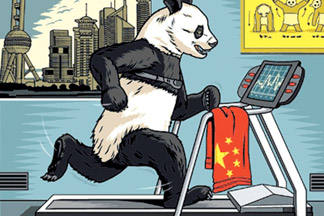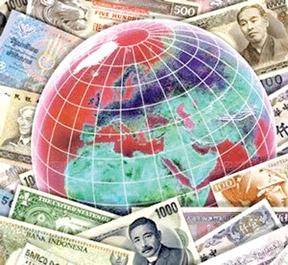Global trade shifting eastward - Ernst & Young
Arjuna HEARTH
Global trade has long been dominated by so-called advanced economies
is now shifting permanently eastwards according to Ernst & Young's
forecast Trading places: The emergence of new patterns of international
trade prepared in conjunction with Oxford Economics. Asia Pacific will
experience the fastest growth in global trade to 2020 and intra-regional
trade there will lead to a renewed concentration of global demand.
 Although global trade collapsed during the financial crisis, it has
since bounced back strongly, led by trade amongst emerging markets.
Global trade was dominated by the advanced nations at the start of the
1990s but their share has declined markedly and this trend is set to
continue its momentum through to 2020. Although global trade collapsed during the financial crisis, it has
since bounced back strongly, led by trade amongst emerging markets.
Global trade was dominated by the advanced nations at the start of the
1990s but their share has declined markedly and this trend is set to
continue its momentum through to 2020.
Gerard Dalbosco, Managing Partner, Markets, Asia-Pacific at Ernst &
Young comments, "While the advanced economies continues to battle
through the financial crisis the rapid-growth markets are going from
strength to strength and are an increasingly significant part of the
global economy. They will become an even more dominant force in global
trade and as a result businesses are going to have to adjust their
strategies to reflect the increasingly regional pattern of world trade
that is developing and will intensify over the next decade."
Global trade across Asia to 2020
Ernst & Young estimates that the continuing shift toward global
outsourcing of production, as well as the growth of regional supply
chains to serve the rapid expansion of demand from rapid-growth markets,
will compress the share of the advanced economies in global trade from a
little over 60% in 2010 to around 55% by 2020.
Asia will continue to be the most dynamic region in terms of trade,
with the fastest growth of exports in goods occurring within the region
itself. India and China will drive the continued rise of the emerging
markets and together these economies will account for almost one-fifth
of global trade flows by 2020.
India and China also represent the fastest growing source of demand
for exports from other countries. The projections show that two of the
most rapidly growing trade routes will be US exports to China and India,
which we see growing at an average annual rate of almost 16%. So while
the US share of world exports fell significantly over the past decade,
our forecasts imply that this trend will be reversed over the next ten
years as the US capitalizes on its strength in exporting to Asia.
Europe's exports to China will rise by $370 billion over the next ten
years. China's exports to Europe at over $1 trillion will be almost
twice as large as US exports to Europe.
Regional patterns of trade
The Asia Pacific region will experience the fastest growth in global
trade to 2020. Indeed, nearly half of Asia-based respondents to our
survey expect to export more than 60% of their output in five years
time, compared with less than a fifth of companies in the Americas.
"The fastest growth of merchandise exports will occur within Asia
itself. More specifically, it will be China and India that lead this
expansion.
 Our bilateral trade forecasts show the fastest-growing trade route
lie between these two economies, with Indian exports to China growing at
an average annual rate of almost 22%, while flows in the opposite
direction expand at an average annual rate of 18.5%. We expect China and
India alone to account for just under one-fifth of global trade flows by
2020," explains Dalbosco. Our bilateral trade forecasts show the fastest-growing trade route
lie between these two economies, with Indian exports to China growing at
an average annual rate of almost 22%, while flows in the opposite
direction expand at an average annual rate of 18.5%. We expect China and
India alone to account for just under one-fifth of global trade flows by
2020," explains Dalbosco.
A trade cluster within Asia has been created, and China has already
become the most important export destination for most Asian economies.
The increasing importance of regional supply chains is a trend that will
help to reinforce the importance of both China and India within the
overall pattern of global trade.
Even as Asia becomes more competitive, a growing share of the
region's exports will be destined for other Asian countries. The growth
of intra-regional trade among Asia's new economic superpowers will lead
to a renewed concentration of global demand, which will be an important
consideration for exporters when making strategic plans for the coming
decade.
China in the center stage
Although wages are rising rapidly in coastal China, the abundance of
cheap labour in the rest of the country will continue to make China an
attractive destination for labour-intensive industries. However, China's
dominance in low-end manufactured goods will increasingly come under
pressure from lower-cost countries such as Bangladesh, Vietnam and parts
of Africa, as China moves up the value chain and its labour costs rise.
India and China will drive the continued rise of the emerging markets
and, together, these economies will become more important to global
trade than the US and Eurozone. For example, measured at current market
exchange rates, the global GDP share of the emerging markets is set to
increase from around 34% in 2010 to 48% by 2020. China's share alone is
forecast to surge from 9% to nearly 20% over this period. These gains
will be at the expense of the advanced economies.
Strong investment by China may help facilitate strong growth in
Africa - enabling the continent to capitalize on its plentiful and
expanding labour force, abundant natural resources, and a more stable
political outlook in some countries.
China's share of global trade in machinery and transport equipment is
projected to rise from 18% to 24% over the same period. This reflects
China's rapid growth of exports in this sector, which is forecast to
average 14% per annum over the next 10 years. By contrast Europe
accounted for 35% of world exports of machinery and transport equipment
in 2010. Even though this share is projected to fall to 32% by 2020,
Europe's head start is large enough that it will make the largest
absolute contribution.
China will account for almost half of the expansion in global exports
of ICT equipment, pushing its share of global trade up to 42%. Although
further expanding in an already large market share will be more
difficult, much of this new trade will reflect the evolution of the
regional supply chain within Asia, with electrical components shipped
between China and other parts in the region. The Rest of Asia region
accounts for a further 21% underscoring the growing importance of Asia
as a technology trade hub.
The US has been proactive in building economic relationships and
trade links with China. These efforts will begin to pay dividends in the
coming years as demand expands and we see this trade route growing at an
average annual rate of almost 16%.
Regional flow of services
Trade in services is also likely to witness rapid growth with Asia
once again leading the way. By 2020, the total flow of services from
Europe to Asia Pacific (excluding Japan) will be larger than to North
America.
As Dalbosco explains, "One of the major drivers of this expansion
will be the growth in banking, insurance and other financial services as
the Asian economies mature and middle class develops. Demand for more
sophisticated financial services is already growing rapidly with rising
wealth levels and the region growing in importance as the financial
center."
It is not just financial services where growth is expected to be
rapid in Asia. Tourism is also likely to be an increasingly important
sector as the number of international tourists travelling from China is
forecast to double from 32m in 2010 to 59m by 2020.
 The increase in associated spending will be even more significant,
rising from $52 billion in 2010 to $222 billion in 2020. The increase in associated spending will be even more significant,
rising from $52 billion in 2010 to $222 billion in 2020.
It is intra-regional trade of services in Europe that will witness
the largest increase over the period. The US and Europe will continue to
dominate services, with China and India only gaining a significant
market share within the rest of Asia.
The machinery and transport equipment sector (which includes consumer
electrical products, such as computers, televisions and washing
machines, as well as industrial machinery) will make the largest
contribution to trade growth over the next ten years, followed by other
manufactures such as textiles, lumber and rubber. In total these
dominant sectors will account for close to 54% of merchandise trade by
2020.
This reflects both the strong growth in demand for consumption and
investment goods expected from emerging markets and the potential to
fragment the supply chain as companies increasingly produce components
in different locations. China's share of global trade in this sector is
projected to rise from 18% to 24%.
Risks and uncertainties
With the global supply changing so rapidly and demand uncertain,
there are a number of alternative scenarios and risks that could
threaten, or boost, global trade growth.
Dalbosco concludes, "Perhaps the most dramatic would be a currency
realignment scenario, implying a rebalancing of domestic demand between
the US and Asia-Pacific region.
This would have significant impacts on projected patterns of trade.
Alternatively, even a partial acceleration of trade liberalization could
drive a larger-than-expected rise in global trade flows."
|



